Salmon Eggs Benedict is a classic breakfast dish that has been enjoyed by many for decades. This dish consists of a toasted English muffin, topped with a slice of Canadian bacon or ham, a poached egg, and a generous drizzle of Hollandaise sauce. However, there are many variations of this dish, and one of the most popular is Eggs Benedict with salmon.
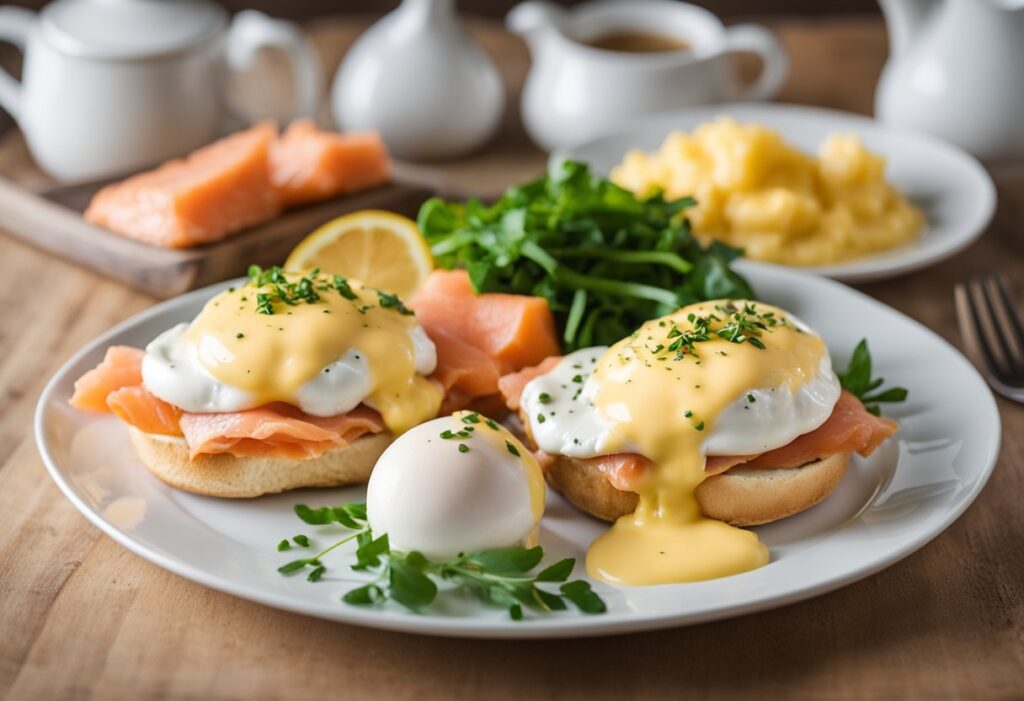
Salmon Eggs Benedict is a delicious and healthy twist on the classic dish. The salmon adds a rich and flavorful element to the dish, and it’s a great way to incorporate more omega-3 fatty acids into your diet. The dish is easy to make and can be served for breakfast, brunch, or even dinner. It’s a crowd-pleaser that will impress your guests and leave them wanting more. In this article, we will share a simple and easy-to-follow recipe for Eggs Benedict with salmon that you can make at home.
Table of Contents
History of Eggs Benedict
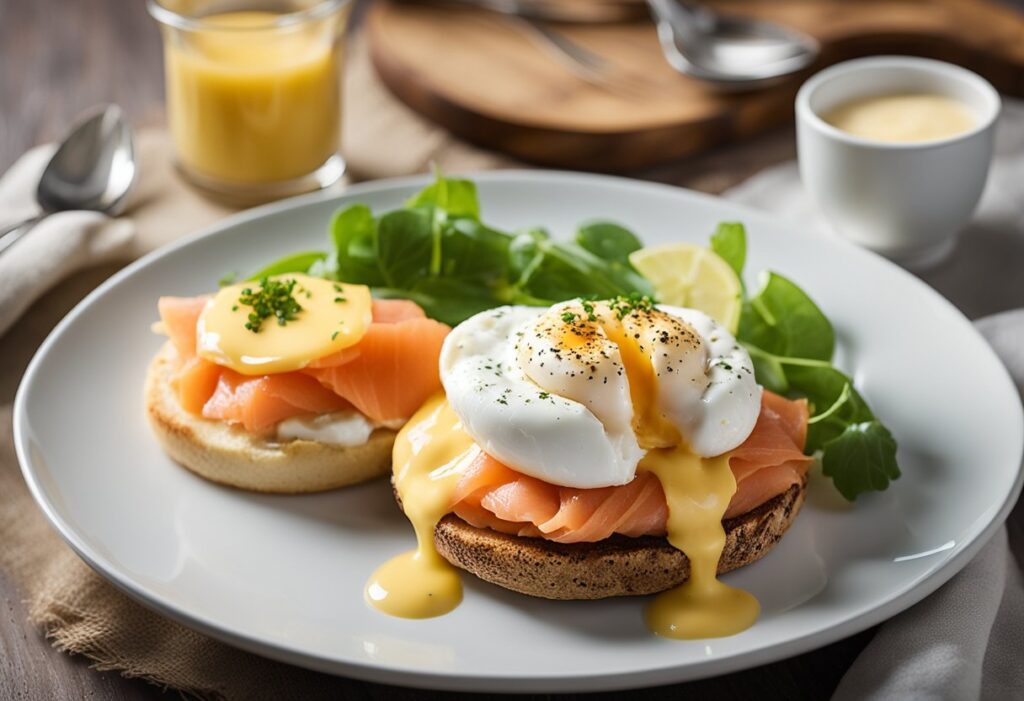
Origin of Salmon Eggs Benedict
Eggs Benedict is a classic American breakfast dish that consists of two halves of an English muffin, each topped with a slice of ham, a poached egg, and hollandaise sauce. The dish is believed to have been created in the late 19th century by a New York City restaurant called Delmonico’s.
Legend has it that a regular patron of the restaurant named Lemuel Benedict ordered a breakfast dish consisting of toast, bacon, poached eggs, and hollandaise sauce. The chef at Delmonico’s, Charles Ranhofer, was so impressed with the combination of ingredients that he added it to the restaurant’s menu and named it Eggs Benedict in honor of the customer who had inspired it.
Incorporation of Salmon
Over time, variations of the classic Eggs Benedict recipe have emerged, including the incorporation of salmon as a substitute for the traditional ham. This variation is often referred to as Eggs Benedict with salmon or Eggs Benedict Royale.
The use of salmon in Eggs Benedict is believed to have originated in the Pacific Northwest region of the United States, where salmon is a popular local ingredient. The substitution of salmon for ham adds a unique flavor to the dish and provides a healthier alternative for those looking to reduce their consumption of red meat.
Today, Eggs Benedict with salmon is a popular breakfast dish served in restaurants across the United States and around the world. Its versatility and delicious taste have made it a staple of the American breakfast menu, and it continues to be enjoyed by people of all ages and backgrounds.
Ingredients of Salmon Eggs Benedict

Fresh Salmon Selection
When it comes to selecting the perfect salmon for your Eggs Benedict dish, it is important to choose a fresh and high-quality piece of fish. Look for salmon that is bright in color, firm to the touch, and has a mild, sweet aroma. Wild-caught salmon is often considered to be the best option due to its superior flavor and texture.
Eggs and Hollandaise Sauce
The key components of Eggs Benedict are the eggs and the hollandaise sauce. For the eggs, it is important to use fresh, high-quality eggs that are free from cracks. For the hollandaise sauce, it is recommended to use clarified butter, fresh lemon juice, and a pinch of cayenne pepper for a tangy and slightly spicy flavor.
Herbs and Seasonings
To enhance the flavor of the dish, a variety of herbs and seasonings can be used. Fresh dill, chives, and parsley are popular options that pair well with the salmon and hollandaise sauce. Other seasonings such as salt, pepper, and paprika can also be used to add a touch of heat and depth of flavor.
Bread Base Options
Traditionally, Eggs Benedict is served on a toasted English muffin. However, there are many other bread options that can be used as a base for the dish. Brioche, sourdough, and even croissants can be used to add a unique twist to the classic dish. It is important to choose a bread that is sturdy enough to hold the salmon and eggs without becoming soggy.
Equipment Needed
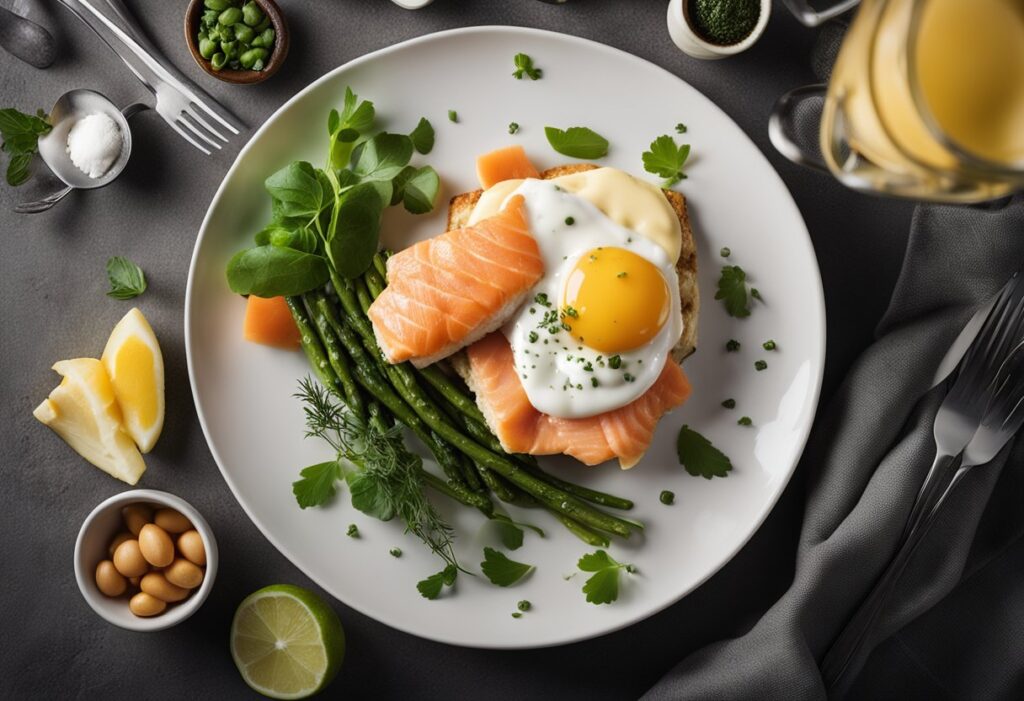
To make the perfect eggs benedict salmon recipe, you will need a few essential pieces of equipment. These include:
1. Saucepan
A saucepan is a must-have for making hollandaise sauce, which is a key component of eggs benedict salmon recipe. A 2-quart saucepan is ideal for this recipe.
2. Whisk
A whisk is essential for making hollandaise sauce. It helps to incorporate air into the sauce, making it light and fluffy. A wire whisk is the best option for this recipe.
3. Blender
A blender is an alternative to a whisk for making hollandaise sauce. It is faster and easier to use, especially if you are making a large batch of sauce.
4. Slotted Spoon
A slotted spoon is essential for poaching the eggs. It helps to remove the eggs from the boiling water without breaking the yolk.
5. Toaster
A toaster is necessary for toasting the English muffins. It helps to give the muffins a crispy texture, which complements the soft poached eggs and creamy hollandaise sauce.
6. Skillet
A skillet is needed for cooking the salmon. A non-stick skillet is the best option for this recipe, as it prevents the salmon from sticking to the pan.
With these essential pieces of equipment, you can easily make the perfect eggs benedict salmon recipe at home.
Preparation Overview

Curing the Salmon
To prepare the salmon for the Eggs Benedict, it needs to be cured beforehand. Curing is a process that preserves the salmon and adds flavor to it. The salmon is covered with a mixture of salt, sugar, and other seasonings and left to cure for several hours. After curing, the salmon is rinsed and sliced thinly.
Poaching the Eggs
Poaching eggs can be a tricky process, but with a few tips, it can be done perfectly every time. Start by bringing a pot of water to a simmer and adding a splash of vinegar to the water. Crack each egg into a small bowl or ramekin and gently slide it into the water. Cook the eggs for about 3-4 minutes until the whites are set but the yolks are still runny. Remove the eggs with a slotted spoon and place them on a paper towel to drain.
Making Hollandaise Sauce
Hollandaise sauce is a rich and creamy sauce that is perfect for Eggs Benedict. To make the sauce, start by whisking egg yolks, lemon juice, and a pinch of salt in a heatproof bowl. Melt butter in a small saucepan over low heat and slowly pour it into the egg mixture while whisking constantly. Continue whisking until the mixture thickens and becomes creamy. Add a pinch of cayenne pepper for a little kick.
Assembling the Dish
To assemble the Eggs Benedict, start by toasting English muffins and placing a slice of cured salmon on each half. Top each salmon slice with a poached egg and drizzle with Hollandaise sauce. Garnish with chopped chives or parsley for added flavor and presentation. Serve immediately.
Cooking Techniques

Timing for Perfect Poached Eggs
Poaching eggs can be a tricky task, but with the right technique, you can achieve the perfect poached egg every time. Firstly, make sure to use fresh eggs as they hold their shape better in the water. Secondly, add a tablespoon of vinegar to the water to help the egg white coagulate. Bring the water to a gentle simmer and then use a spoon to create a whirlpool in the center of the pot. Crack the egg into a small bowl and then gently pour it into the center of the whirlpool. Cook the egg for 3-4 minutes until the whites are set but the yolk is still runny.
Achieving Silky Hollandaise
To make a silky smooth Hollandaise sauce for Eggs Benedict, ensure the butter is melted and hot but not boiling. Whisk egg yolks, lemon juice, salt, and cayenne in a heatproof bowl over simmering water, avoiding direct contact with the water. Whisk until thick and doubled in volume. Remove from heat and slowly drizzle in the hot butter, whisking until smooth and creamy. Thin with warm water if needed.
Serving Suggestions
Plating
When it comes to plating, the eggs benedict salmon recipe is a versatile dish that can be served in various ways. For a classic presentation, place the toasted English muffin halves on a plate, followed by a slice of smoked salmon on each half. Carefully place the poached egg on top of the salmon, and spoon the hollandaise sauce over the eggs.
For a more elegant presentation, consider using a ring mold to shape the salmon into a cylinder and placing it on top of the English muffin. Then, place the poached egg on top of the salmon, followed by the hollandaise sauce. This will create a visually appealing dish that is sure to impress your guests.
Garnishes
Garnishes can add a pop of color and flavor to your eggs benedict salmon dish. Consider adding a sprinkle of chopped fresh herbs, such as chives, parsley, or dill, over the hollandaise sauce. This will not only add flavor but also create a beautiful contrast against the yellow sauce.
Another great garnish option is a sprinkle of paprika or cayenne pepper over the hollandaise sauce. This will add a subtle kick of heat and a vibrant red color to your dish.
Finally, you can also add some fresh greens, such as arugula or watercress, to the plate. This will add a refreshing crunch and a pop of color to your dish, making it look even more appetizing.
Overall, the serving suggestions for the eggs benedict salmon recipe are endless. By using your creativity and experimenting with different plating and garnish options, you can create a unique and delicious dish that will impress your guests.
Nutritional Information

Eggs Benedict with salmon is a delicious and satisfying dish that can be enjoyed for breakfast, brunch, or even lunch. This dish is rich in protein, healthy fats, and essential vitamins and minerals.
One serving of eggs benedict with salmon contains approximately 450-500 calories, depending on the portion size and the ingredients used. It is also a good source of omega-3 fatty acids, which are essential for heart health and brain function.
The dish is also high in protein, with one serving containing around 25-30 grams of protein. Protein is essential for building and repairing muscle tissue, as well as for maintaining a healthy immune system.
In addition to protein and healthy fats, eggs benedict with salmon also contains essential vitamins and minerals such as vitamin D, vitamin B12, and selenium. Vitamin D is important for bone health and immune function, while vitamin B12 is essential for nerve function and the formation of red blood cells. Selenium is a powerful antioxidant that helps protect against cell damage and supports a healthy immune system.
Overall, eggs benedict with salmon can be a nutritious and satisfying meal that provides a range of essential nutrients. However, it is important to enjoy this dish in moderation as it can be high in calories and sodium.
Storage and Leftovers
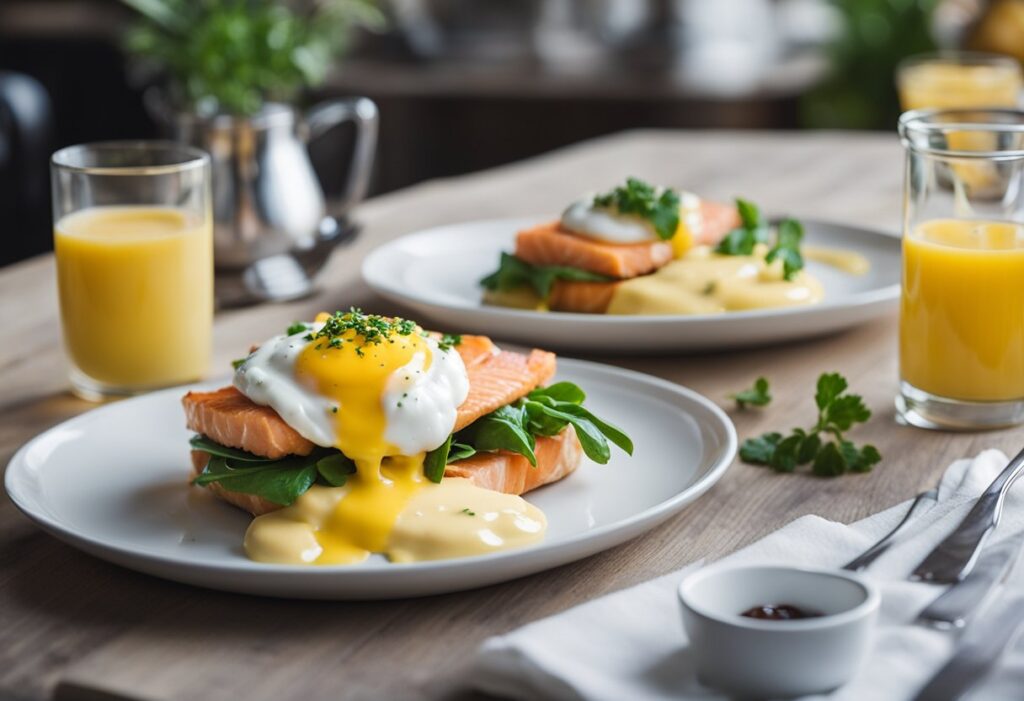
Once prepared, Eggs Benedict with salmon should be consumed immediately for the best taste and texture. However, if you have leftovers, they can be stored in the refrigerator for up to two days.
To store, place the Eggs Benedict with salmon in an airtight container and refrigerate promptly. When reheating, it is recommended to reheat the eggs and hollandaise sauce separately to avoid overcooking the eggs.
It is important to note that the texture of the salmon may change when reheated, becoming slightly tougher. For this reason, it is recommended to consume the leftovers within a day or two to ensure optimal taste and texture.
When reheating, the eggs and hollandaise sauce can be gently reheated in a saucepan over low heat or in the microwave in short intervals, stirring frequently.
Overall, while Eggs Benedict with salmon is best consumed fresh, leftovers can be stored and reheated with care to enjoy the dish for an additional day or two.
Variations of Eggs Benedict with Salmon
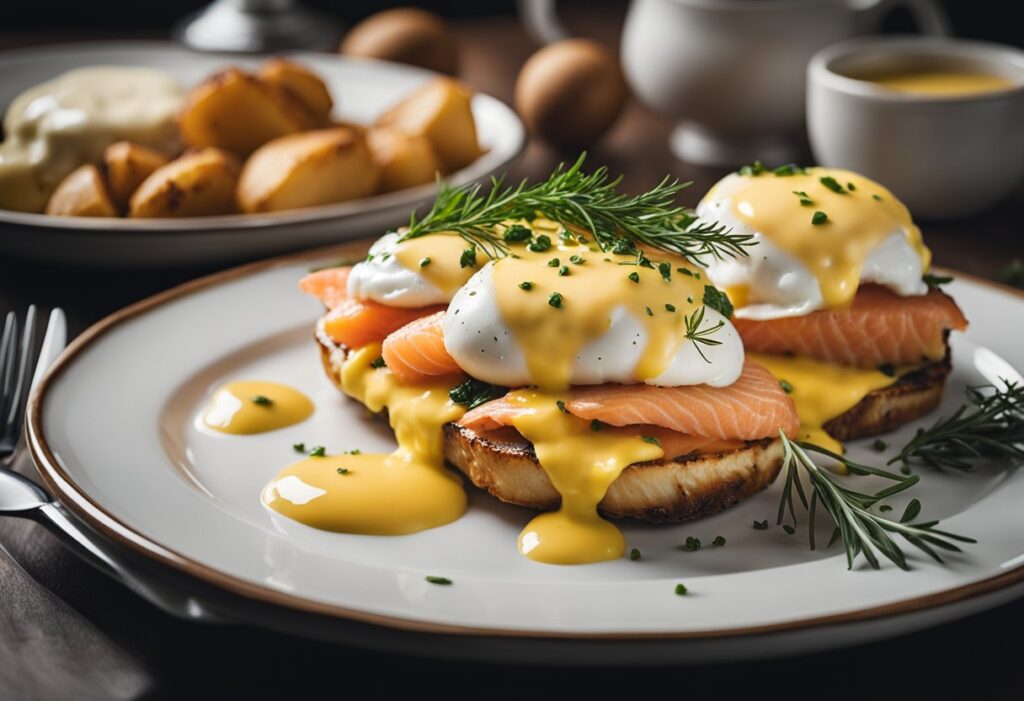
Eggs Benedict with salmon is a popular dish that can be enjoyed in different ways. Here are some variations of this classic breakfast dish:
1. Smoked Salmon Eggs Benedict
Instead of poached salmon, smoked salmon can be used to add a different flavor to the dish. The smoked salmon is placed on top of the toasted English muffin, followed by the poached egg and hollandaise sauce. This variation is a great option for those who prefer a smoky flavor.
2. Avocado Salmon Eggs Benedict
For a healthier option, avocado can be added to the Eggs Benedict with salmon. The avocado is sliced and placed on top of the toasted English muffin, followed by the poached egg and salmon. The hollandaise sauce can be replaced with a healthier sauce such as avocado sauce or a light lemon vinaigrette.
3. Crab Cake Eggs Benedict with Salmon
This variation combines the flavors of crab cakes and salmon. A crab cake is placed on top of the toasted English muffin, followed by the poached egg and salmon. The hollandaise sauce can be flavored with Old Bay seasoning to complement the crab cake.
4. Spinach and Feta Salmon Eggs Benedict
For a vegetarian option, spinach and feta can be added to the Eggs Benedict with salmon. The spinach is sautéed and placed on top of the toasted English muffin, followed by the poached egg and salmon. The hollandaise sauce can be flavored with feta cheese to complement the spinach.
These variations of Eggs Benedict with salmon are easy to make and can add a new twist to the classic breakfast dish. Whether you prefer smoky, healthy, seafood, or vegetarian flavors, there is a variation for everyone to enjoy.

